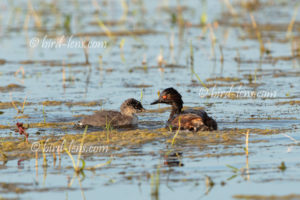 Black-necked Grebes (Podiceps nigricollis) are really avian vagabonds with exciting distribution patterns and many open questions in behaviour. With their orange ears on their black heads and bright red eyes, Black-necked Grebes in their breeding plumage are eye-catchers and unmistakable. Outside the breeding season, not only Black-necked Grebes look significantly different. In the whitish-black plain dress, the Black-necked Grebes are confusingly similar to the Horned Grebes (Podiceps auritus). Horned Grebes can only be distinguished from Black-necked Grebes on closer inspection by a stronger and, above all, not raised beak and details in the head drawing.
Black-necked Grebes (Podiceps nigricollis) are really avian vagabonds with exciting distribution patterns and many open questions in behaviour. With their orange ears on their black heads and bright red eyes, Black-necked Grebes in their breeding plumage are eye-catchers and unmistakable. Outside the breeding season, not only Black-necked Grebes look significantly different. In the whitish-black plain dress, the Black-necked Grebes are confusingly similar to the Horned Grebes (Podiceps auritus). Horned Grebes can only be distinguished from Black-necked Grebes on closer inspection by a stronger and, above all, not raised beak and details in the head drawing.
But in breeding plumage, the 2 bird species are easy to determine. During the long moulting period, which mainly occurs between mid-July and mid-August, both birds are sometimes not as conspicuous as one might think. After the wings have been thrown off, they also moult the small feather and gradually into a plain non-breeding plumage. In this phase in midsummer they like to “hide” between other moulting water birds and are sometimes difficult to distinguish from even the Little Grebe (Tachybaptus ruficollis). The moult is a particularly sensitive phase for water bird species due to its inability to fly for around three weeks. They are then shy and receive less attention from ornithologists than at other times of the year. An analysis of the distribution is useful as this species is known to change breeding sites quite often, they vagabonds. Basically it can be said that Black-necked Grebes can be found in Central Europe all year round. Meanwhile, the magnitudes in winter are at the level of the numbers for the breeding season. They can be observed as breeding and resting birds in all regions, but many of the 900 to 1100 pairs (over the period from 2011 to 2016) are concentrated in a few larger colonies. After increases in many regions up to the 2000s, the last analysis of the population situation assessed both the 12 and 24 year trend as a moderate decrease. However, the breeding occurrences are characterized by high spatial and temporal dynamics.
Black-necked Grebes know how to use favorable conditions surprisingly spontaneously in individual years, as if “scouts” were permanently on the move, which guide other birds to new habitats and locations. One example is the spontaneous emergence of a breeding colony at the Alfsee in the Landkreis (district) Osnabrück in Lower Saxony in June 2011 with 52 pairs which tried to use the favorable conditions through the mass occurrence of emergent water plants. It goes without saying that not all breeding occurrences emerge and disappear so quickly; there are also numerous breeding sites that have been occupied for decades and are often located near colonies of gulls, especially those of the Common Black-headed Gull (Larus ridibundus).
One other example is an occurrence in southern Brandenburg. In a vast shallow lake area, the Rietzer See near Kloster Lehnin, the numbers are impressive since the beginning of counting and on April 13, 2012 more than 110 Black-necked Grebes were counted.
It was not until 2011 that the first Black-necked Grebes appeared at the Reckahner ponds, also in the municipality of Kloster Lehnin, but in a fish pond farm. Then there were no more reports for 7 years and then from 2018 onwards some reports, which then culminated in a number of half a dozen breeding birds in 2020. Thus, you can see a high level of local variability on Brandenburg localities as well.
In order to meet the growing demand for top images of the rarer species of Palaearctic Bird-lens.com has specifically made trips to remote places. Additionally every chance is used, if a rare bird is around the homeground. This to do everything to ensure excellent photos of the Birds of the Western Palearctic . The yield of pictures also of rare Western Palaearctic birds is very good. There are other nice images of birds, that you will find behind the tab “Picture Shop“. Just give a notice if you need a picture of a bird which is not online
Tag: